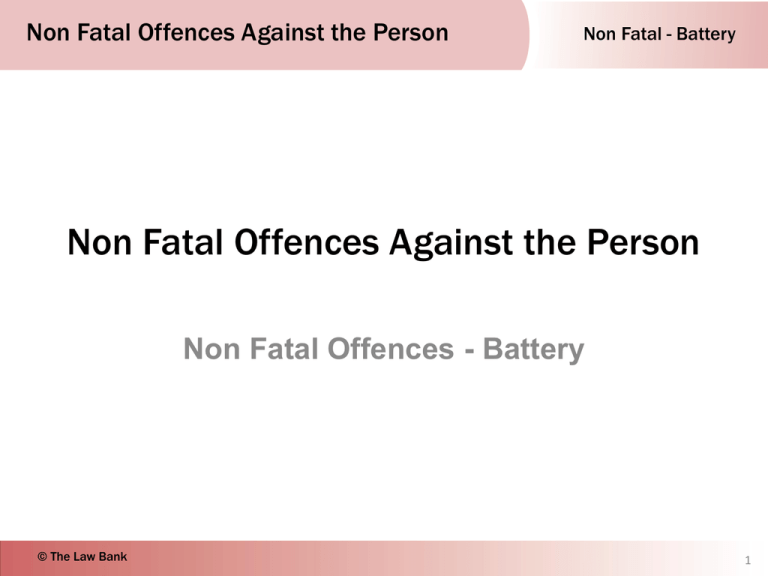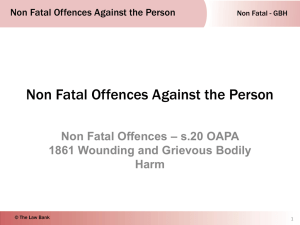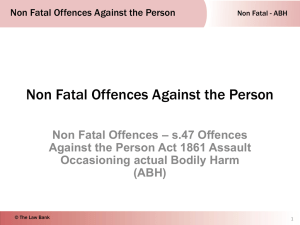Non Fatal Offences - Battery
advertisement

Non Fatal Offences Against the Person Non Fatal - Battery Non Fatal Offences Against the Person Non Fatal Offences - Battery © The Law Bank 1 Non Fatal Offences Against the Person Non Fatal - Battery Objectives • Describe using authority the actus reus of battery • Describe using authority the mens rea of battery • Apply the actus reus and mens rea of battery to problem questions © The Law Bank 2 Non Fatal Offences Against the Person Non Fatal - Battery Battery • Battery is an act by which a person intentionally or recklessly inflicts unlawful personal violence on another • (Law Commission (1993) Legislating the Criminal Code). • Confirmed in R v Ireland (1997) and R v Burstow (1997) © The Law Bank 3 Non Fatal Offences Against the Person Non Fatal - Battery Actus Reus • The infliction of unlawful personal violence – But also consider: • Direct or indirect • Non-consensual • Physical contact © The Law Bank 4 Non Fatal Offences Against the Person Non Fatal - Battery Direct/Indirect • Can be – Direct unlawful physical contact (one person touching another as in Collins v. Wilcock) © The Law Bank 5 Non Fatal Offences Against the Person Non Fatal - Battery Collins v Wilcock (1984) Case Law Assault - definition of - apprehension of immediate force - mens rea is recklessness or intention - everyday jostling is not assault D refused to speak to a police officer. The officer took hold of D's arm to restrain her. D scratched the officer's arm. Principle – Goff LJ: 'An assault is an act which causes another person to apprehend the infliction of immediate, unlawful, force on his person; a battery is the actual infliction of unlawful force on another person ... any touching of another person, however slight, may amount to battery.' "Consent is a defence to battery; and most of the physical contacts of ordinary life are not actionable because they are impliedly consented to by all who move in society and so expose themselves to the risk of bodily contact… it is more common nowadays to treat…everyday jostling…as falling within a general exception embracing all physical contact which is generally acceptable in the ordinary conduct of daily life.” Not Guilty (unlawful contact) © The Law Bank 6 Non Fatal Offences Against the Person Non Fatal - Battery Direct/Indirect • Can be – Direct unlawful physical contact (one person touching another as in Collins v. Wilcock) – Indirect unlawful physical contact (where one person touches another and contact is made with a third person as in Haystead [2003]) © The Law Bank 7 Non Fatal Offences Against the Person Non Fatal - Battery Haystead v DPP (2000) Case Law Actus reus – battery – indirect force D assaulted a child by punching the child's mother causing the child to fall and hit his head. He argued that battery required the direct application of force which involved direct physical contact with the victim either with the body or with a medium such as a weapon. Principle – Battery did not require the direct infliction of violence and that H's act had been comparable to using a weapon to cause the child to fall. Although D had punched the complainant and not the child that she had been holding, the punches had caused the child to be dropped and therefore the magistrates had been entitled to find D guilty of assaulting the child by beating Guilty © The Law Bank 8 Non Fatal Offences Against the Person Non Fatal - Battery Indirect • • • • So batteries can be inflicted indirectly First example of this Martin (1881) Backed up in DPP v K (1990) And confirmed again in Haystead (2000) © The Law Bank 9 Non Fatal Offences Against the Person Non Fatal - Battery R v Martin (1881) Case Law Actus Reus of battery = inflicting unlawful personal violence - intentionally or recklessly – indirect force D positioned an iron bar in a theatre across an exit, as a joke, turned out the lights on a staircase and yelled 'Fire!'. As a result, several people were injured. Principle – Lord Coleridge CJ: 'The prisoner must be taken to have intended the natural consequences of that which he did.’ An assault as such was not essential to the offence; some unlawful act and the foresight of harm would be enough. "Inflict" meant no more than "cause" and did not require a face-to-face assault. Guilty © The Law Bank 10 Non Fatal Offences Against the Person Non Fatal - Battery DPP v K (1990) Case Law ABH - harm caused indirectly – indirect force D placed acid in a hot air drier to hide it from his teachers. V then used the drier and the acid caused burns on his face. Principle – Parker LJ: D had ‘just as truly assaulted the next user of the machine [V] as if [D] had himself switched the machine on’. If the charge was simply battery, it is not necessary to prove harm. Guilty of ABH © The Law Bank 11 Non Fatal Offences Against the Person Non Fatal - Battery Omissions • Generally has to be an act not an omission – this is why the Court ruled that the circumstances in Fagan were a continuing act • Battery can be committed by an omission but only if a duty to act can be found • See Santana Bermudez (2004) © The Law Bank 12 Non Fatal Offences Against the Person Non Fatal - Battery Consensual • Battery requires non-consensual touching • Consent can be express (victim agrees) or • Implied (from the inevitable contact Collins v Wilcock) • Consent is a main consideration in the lawful/unlawful distinction © The Law Bank 13 Non Fatal Offences Against the Person Non Fatal - Battery Physical Contact • Must be some physical contact • Merest contact will suffice i.e. touching a persons clothes (Thomas) • The touching should be hostile – everyday contact allowable (Wilson & Pringle, Brown and others) • Everyday contact must not exceed boundaries of normality © The Law Bank 14 Non Fatal Offences Against the Person Non Fatal - Battery R v Thomas (1985) Case Law Assault – must be indecent - assault is - merest touch D, a school caretaker assaulted a 12-year-old after taking hold of the hem of her skirt. Principle – the act was not inherently indecent and there was no evidence of circumstances making it so. But Ackner LJ said obiter that there can be no dispute that if you touch a person’s clothes while he is wearing them, that is equivalent to touching him. Not Guilty © The Law Bank 15 Non Fatal Offences Against the Person Non Fatal - Battery Collins v Wilcock (again) (1984) Case Law Assault – everyday contact Principle – Lord Goff – Most of the physical contacts of ordinary life re not actionable because they are impliedly consented to by all who move in society and so expose themselves to the risk of bodily contact. So nobody can complain of the jostling which is inevitable from his presence in, for example, a supermarket, an underground station or a busy street, nor can a person who attends a party complain if his hand is seized in friendship, or even his back is [within reason] slapped. © The Law Bank 16 Non Fatal Offences Against the Person Non Fatal - Battery Wilson v Pringle (1986) Case Law Assault - actus reus of battery D a schoolboy, in fun seized the bag over C's shoulder, causing him injury, and C sued for the tort of assault. Principle – C must establish an intentional and hostile touching of one person by another, though not necessarily an intent to injure. A claimant who cannot prove hostility on the defendant's part is likely to fail, because in a crowded world people must be considered to take upon themselves some risk of injury from the lawful acts of others. C lost © The Law Bank 17 Non Fatal Offences Against the Person Non Fatal - Battery Joint Charging Standards Battery Actual Bodily Harm Scratches/grazes Temporary loss of sensory functions Minor bruising Extensive or multiple bruising Superficial cuts Minor cuts requiring stitching Black eyes Minor Fractures Agreed by Police and CPS and were produced in order to clarify the offences that would normally be charged following different levels of injury. WARNING – Do not rely on these for your offence recognition – to do so neglects key elements of mens rea © The Law Bank 18 Non Fatal Offences Against the Person Non Fatal - Battery Mens rea • Straightforward: • Intention to make direct/indirect non consensual physical contact with another Venna [1976] or • Subjective recklessness thereto (the defendant must foresee a risk that the victim will apprehend immediate unlawful violence) • Cunningham subjective recklessness – what the defendant actually foresaw rather than what he ought to have foreseen © The Law Bank 19 Non Fatal Offences Against the Person Non Fatal - Battery R v Venna (1976) Case Law Assault - mens rea is recklessness or intention D struggled with the police officers who were arresting him. D fell to the ground and lashed out wildly with his legs, fracturing a bone in the hand of an officer. Principle – "The offence of battery is satisfied by proof that the defendant intentionally or recklessly applied force to the person of another.” Guilty of ABH © The Law Bank 20 Non Fatal Offences Against the Person Non Fatal - Battery Objectives • Describe using authority the actus reus of battery • Describe using authority the mens rea of battery • Apply the actus reus and mens rea of battery to problem questions © The Law Bank 21 Non Fatal Offences Against the Person Non Fatal - Battery Plenary • Abi has been sponsored for charity to hug as many people as she can in 60 minutes. She sees Andrew in the street and shouts ‘I am going to give you a great big hug!’ Andrew does not want to be hugged by a stranger and replies ‘No thanks, not today.’ Abi ignores this and hugs him anyway. • Explain you answer using case law © The Law Bank 22 Non Fatal Offences Against the Person Non Fatal - Battery Plenary • Rachel has recently split up from her violent boyfriend Sam. She is sitting in a bus in a traffic jam when she receives a text from him saying ‘You are going to die. Terrified she looks out of the window and sees him sitting in a café on the other side of the road. • Explain you answer using case law © The Law Bank 23










